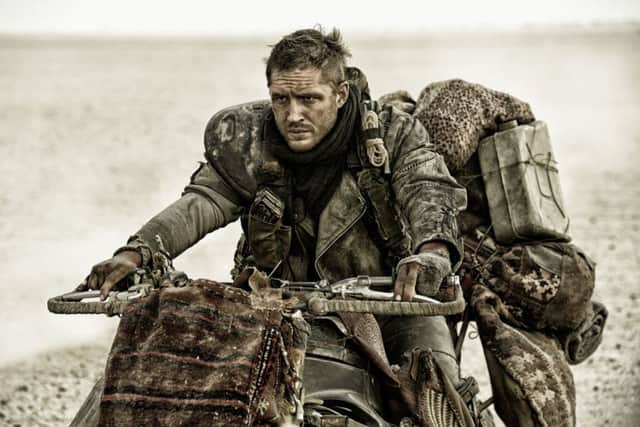The 10 best films of 2015


1. Mad Max: Fury Road
Exposing most of the year’s biggest movies – Spectre, Avengers: Age of Ultron, Jurassic World – for the bloated blockbuster spectacles they were, Mad Max: Fury Road pole-vaulted its way into prime position as 2015’s best movie through sheer audacity. Making a deliriously deranged return to the cinematic landscape he last visited 30 years ago, George Miller took a $150m budget and thumbed his nose at the conventions of safe franchise filmmaking to deliver a properly out-there, old-school exploitation flick that revelled in the fringe lunacy of its own low-budget inspiration. Taking over from Mel Gibson, Tom Hardy made the Road Warrior as certifiable as he was angry, but the real star was Charlize Theron’s skin-headed, one-armed, war rig-driving Furiosa, out to liberate a harem of beautiful “breeders” from the clutches of a demented warlord. Though effectively one long desert car chase, the film worked as a symphony of automotive carnage, with Miller conducting all the crashes, airborne collisions and inter-vehicle punch-ups with a maestro’s understanding of harmony, layering everything into dizzying arpeggios of annihilation that gave narrative shape to ensuing mayhem.
2. Whiplash


Thanks to the abysmal 50 Shades of Grey and the brilliant Duke of Burgundy there was a lot of actual sadomasochism in 2015, but the year’s most extreme sub-dom relationship was to be found in Whiplash, Damien Chazelle’s ridiculously entertaining jazz drama about a drumming prodigy (Miles Teller) desperate for the approval of his black-clad, half-mad conservatoire teacher. Playing the latter with the ferocity of a drill sergeant, an Oscar-winning JK Simmons delivered the performance of the year as Fletcher, a self-styled custodian of greatness who sees it as his job to fling chairs, cymbals and any number of eye-wateringly emasculating insults at his pupils in an effort to draw out artistic genius and eradicate the “good job” blandishments that make the rest of the world mediocre.
3. It Follows
Advertisement
Hide AdGood horror concepts are few and far between, but writer/director David Robert Mitchell came up with a brilliantly simple and effective one for this dreamy riff on the slasher movie. Paying homage to Halloween, A Nightmare on Elm Street and The Ring with a shape-shifting demon invisible to all but its victims, the film’s ingenious twist was to make the curse that brings ‘It’ into existence transmissible through sex, opening up a complex set of moral dilemmas for its protagonists and creating a whole lot of subtextual intrigue. But what really hit home hardest was the way the premise reflected how any profound experience can quickly become a half-remembered dream with the power to haunt you for the rest of your days.
4. Listen Up Philip
There was no more literate movie in 2015 than Alex Ross Perry’s unapologetically acerbic comedy/drama about an up-and-coming New York novelist who uses the publication of his second novel as an excuse to embrace the appalling behavioural ticks of his literary forebears. Featuring a wonderfully loathsome Jason Schwartzman as the titular Philip Lewis Friedman (and a magnificent turn from Jonathan Pryce as his Philip Roth-like enabler), the film made sure his tragically heightened self-regard was as amusing as it was repellant. It also took real narrative chances, shifting perspective at certain points via the film’s beautifully written omniscient narration (voiced by Eric Bogosian) and Ross Perry’s bold decision to focus for large chunks of the running time on Philip’s suddenly abandoned girlfriend Ashley (Elisabeth Moss).
5. Inside Out
Just when it seemed as if Pixar was becoming too reliant on sequels to its first wave of impeccably crafted hits, along came Inside Out to remind us of the mind-bending conceptual flights of fancy the animation studio is capable of pulling off. Set inside the head of a little girl whose personified emotions govern her everyday actions, the film showed how Anger, Disgust, Fear and Sadness start to dominate Riley’s life after she moves with her family to a new city – leaving Joy (voiced by Parks & Recreation star Amy Poehler) with a battle on her hands to regain control of this once-happy little girl’s mind. The abstract concept was ingeniously realised and the resulting film was Pixar’s most emotionally complex yet: as heartbreaking as it was delightful.
6. Diary of a Teenage Girl
Functioning almost as a spiritual sequel or companion piece to Inside Out (it even took place in the same city), Marielle Heller’s directorial debut was a provocative, achingly honest and intimate insight into the mindset of a 15-year-old girl testing her sexual boundaries amidst the soured “free love” counterculture experiment of mid-1970s San Francisco. Featuring a star-making turn from British actress Bel Powley in the lead, its candid, witty and wise exploration of female sexuality should have been required viewing for all teenagers regardless of gender. Unfortunately the BBFC slapped it with an unnecessarily punitive 18 certificate.
7. Ex_Machina
Just edging out Danny Boyle’s Steve Jobs as the year’s best tech film, Boyle’s former collaborator Alex Garland made a stunning directorial debut with this elegantly stripped-down sci-fi thriller about artificial intelligence. Revolving around a billionaire tech guru (Oscar Isaac) who brings in a young programmer (Domhnall Gleeson) to perform a Turing test on a female robot (Alicia Vikander), the film was fully attuned to its more blockbuster elements yet pleasingly cerebral at the same time. It also put an intriguing feminist slant on the genre by casting its male characters as two sides of the same patriarchal problem: one trying to play god, the other desperate to play the prescribed role of the hero, but both blind to Ava’s complexity and capacity for independent thought and action.
8. Sicario
Mainlining dread, drama and stunningly orchestrated action sequences, Sicario dropped us into the front line of the drug war, with Emily Blunt brilliant as a tough, capable, admirably pragmatic FBI agent who finds her moral code challenged after joining an inter-agency task force headed up by the CIA. Prisoners director Denis Villeneuve’s muscular approach to the material recalled Michael Mann, but working once again with genius cinematographer Roger Deakins, their bravura efforts set a new template for how this kind of film could and should be done.
9. Slow West
Advertisement
Hide AdThanks to Macbeth and Sunset Song, 2015 wasn’t short of artistically daring movies with a Scottish bent, but the most intriguing and ambitious was this debut feature from ex-Beta Band keyboardist turned director John Maclean. A darkly humorous, off-kilter western, it starred The Road’s Kodi Smit-McPhee as the young son of a Scottish aristocrat who runs off to America in pursuit of the girl he loves. Woefully unprepared for life on the frontier, he teams up with Michael Fassbender’s bounty hunter, little realising his protector might have ulterior motives for offering to help. Maclean imbues this classic western set-up with entertainingly strange digressions, hard-hitting shoot-outs and gnarly action.
10. Cobain: Montage of Heck
Twenty-one years on from the suicide of Nirvana frontman Kurt Cobain, this experimental documentary trawl through Cobain’s short life served up a searing, intimate and moving portrait of a mentally scarred artist that neither romanticised his anguish nor glossed over the realities of suddenly finding yourself in the biggest band on the planet. The latter made this an interesting companion piece to the more widely seen – and also excellent – Amy, but what really surprised (and was probably responsible for annoying those who wanted a straight history lesson on the band) was how its narrative techniques ultimately reflected the disconnect that existed at the time between the mainstream’s determination to co-opt and commodify Nirvana’s music and the band’s understandable desire to let that music speak for itself. Courtney Love’s startling honesty also put paid to any notions that this was in anyway hagiographic towards her or her late husband and while unlikely to be the last word on the subject, it certainly deserves to be. n